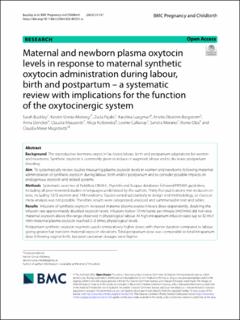| dc.contributor.author | Buckley, Sarah | |
| dc.contributor.author | Uvnäs-Moberg, Kerstin | |
| dc.contributor.author | Pajalic, Zada | |
| dc.contributor.author | Luegmair, Karolina | |
| dc.contributor.author | Ekström-Bergström, Anette | |
| dc.contributor.author | Dencker, Anna | |
| dc.contributor.author | Massarotti, Claudia | |
| dc.contributor.author | Kotlowska, Alicja | |
| dc.contributor.author | Callaway, Leonie | |
| dc.contributor.author | Morano, Sandra | |
| dc.contributor.author | Olza, Ibone | |
| dc.contributor.author | Meier Magistretti, Claudia | |
| dc.date.accessioned | 2023-03-07T08:36:08Z | |
| dc.date.available | 2023-03-07T08:36:08Z | |
| dc.date.created | 2023-01-06T15:04:38Z | |
| dc.date.issued | 2023 | |
| dc.identifier.citation | BMC Pregnancy and Childbirth. 2023, 23, Article number: 137, 1-56 | en_US |
| dc.identifier.issn | 1471-2393 | |
| dc.identifier.uri | https://hdl.handle.net/11250/3056231 | |
| dc.description | This article is licensed under a Creative Commons Attribution 4.0 International License, which permits use, sharing, adaptation, distribution and reproduction in any medium or format, as long as you give appropriate credit to the original author(s) and the source, provide a link to the Creative Commons licence, and indicate if changes were made. The images or other third party material in this article are included in the article’s Creative Commons licence, unless indicated otherwise in a credit line to the material. If material is not included in the article’s Creative Commons licence and your intended use is not permitted by statutory regulation or exceeds the permitted use, you will need to obtain permission directly from the copyright holder. To view a copy of this licence, visit http://creativecommons.org/licenses/by/4.0/. The Creative Commons Public Domain Dedication waiver (http://creativeco mmons.org/publicdomain/zero/1.0/) applies to the data made available in this article, unless otherwise stated in a credit line to the data | en_US |
| dc.description.abstract | Background: The reproductive hormone oxytocin facilitates labour, birth and postpartum adaptations for women and newborns. Synthetic oxytocin is commonly given to induce or augment labour and to decrease postpartum bleeding.
Aim: To systematically review studies measuring plasma oxytocin levels in women and newborns following maternal administration of synthetic oxytocin during labour, birth and/or postpartum and to consider possible impacts on endogenous oxytocin and related systems.
Methods: Systematic searches of PubMed, CINAHL, PsycInfo and Scopus databases followed PRISMA guidelines, including all peer-reviewed studies in languages understood by the authors. Thirty-fve publications met inclusion cri teria, including 1373 women and 148 newborns. Studies varied substantially in design and methodology, so classical meta-analysis was not possible. Therefore, results were categorized, analysed and summarised in text and tables.
Results: Infusions of synthetic oxytocin increased maternal plasma oxytocin levels dose-dependently; doubling the infusion rate approximately doubled oxytocin levels. Infusions below 10 milliunits per minute (mU/min) did not raise maternal oxytocin above the range observed in physiological labour. At high intrapartum infusion rates (up to 32mU/ min) maternal plasma oxytocin reached 2–3 times physiological levels. Postpartum synthetic oxytocin regimens used comparatively higher doses with shorter duration compared to labour, giving greater but transient maternal oxytocin elevations. Total postpartum dose was comparable to total intrapartum dose following vaginal birth, but post-caesarean dosages were higher Newborn oxytocin levels were higher in the umbilical artery vs. umbilical vein, and both were higher than maternal plasma levels, implying substantial fetal oxytocin production in labour. Newborn oxytocin levels were not further elevated following maternal intrapartum synthetic oxytocin, suggesting that synthetic oxytocin at clinical doses does not cross from mother to fetus.
Conclusions: Synthetic oxytocin infusion during labour increased maternal plasma oxytocin levels 2–3-fold at the highest doses and was not associated with neonatal plasma oxytocin elevations. Therefore, direct efects from synthetic oxytocin transfer to maternal brain or fetus are unlikely. However, infusions of synthetic oxytocin in labour change uterine contraction patterns. This may infuence uterine blood fow and maternal autonomic nervous system activity, potentially harming the fetus and increasing maternal pain and stress. | en_US |
| dc.language.iso | eng | en_US |
| dc.publisher | BioMed Central (BMC) | en_US |
| dc.rights | Navngivelse 4.0 Internasjonal | * |
| dc.rights.uri | http://creativecommons.org/licenses/by/4.0/deed.no | * |
| dc.subject | augmentation of labour | en_US |
| dc.subject | induction of labour | en_US |
| dc.subject | postpartum oxytocin | en_US |
| dc.subject | syntocinon | en_US |
| dc.subject | pitocin | en_US |
| dc.subject | synthetic oxytocin | en_US |
| dc.subject | newborn oxytocin | en_US |
| dc.subject | maternal oxytocin | en_US |
| dc.subject | oxytocin | en_US |
| dc.title | Maternal and newborn plasma oxytocin levels in response to maternal synthetic oxytocin administration during labour, birth and postpartum – a systematic review. | en_US |
| dc.type | Peer reviewed | en_US |
| dc.type | Journal article | en_US |
| dc.description.version | publishedVersion | en_US |
| dc.rights.holder | © The Author(s) 2023. | en_US |
| dc.source.pagenumber | 1-56 | en_US |
| dc.source.volume | 23 | en_US |
| dc.source.journal | BMC Pregnancy and Childbirth | en_US |
| dc.identifier.doi | https://doi.org/10.1186/s12884-022-05221-w | |
| dc.identifier.cristin | 2102263 | |
| dc.source.articlenumber | 137 | en_US |
| cristin.ispublished | true | |
| cristin.fulltext | original | |
| cristin.qualitycode | 1 | |

